Richard Seddon
| The Right Honourable Richard John Seddon | |
|---|---|
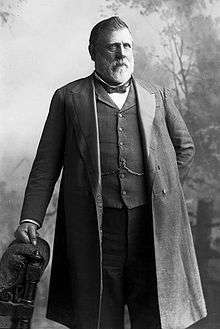 Rt. Hon. Richard Seddon in 1905. | |
| 15th Prime Minister of New Zealand[* 1] | |
|
In office 27 April 1893 – 10 June 1906 | |
| Monarch |
Victoria Edward VII |
| Governor |
David Boyle Uchter Knox William Plunket |
| Preceded by | John Ballance |
| Succeeded by | William Hall-Jones |
| Constituency | Westland |
| Personal details | |
| Born |
22 June 1845 Eccleston, England |
| Died |
10 June 1906 (aged 60) At sea |
| Political party |
Independent (1879–91) Liberal (1891–1906) |
| Spouse(s) | Louisa Jane Spotswood (m. 1869) |
| Children | 9, including Tom Seddon |
| Religion | Anglican |
| |
Richard John Seddon PC (22 June 1845 – 10 June 1906) is to date the longest-serving Prime Minister of New Zealand. He is regarded as one of New Zealand's greatest political leaders. Sometimes derisively known as King Dick for his autocratic style,[2] Seddon dominated the Liberal government for thirteen years, achieving many social and economic changes.
Early life and family
Seddon was born in Eccleston near St Helens, Lancashire, England in 1845. His father Thomas Seddon (born 1817) was a school headmaster, and his mother Jane Lindsay was a teacher. They married on 8 February 1842 at Christ Church, Eccleston. Their children were:
- Thomas born 1842, who died 1849
- Phoebe Ellen born 1843 died 1925 in New Zealand.
- Richard John born 1845, the subject of this article
- Edward Youd, born 1847 died 1919 in Greymouth
- William born 1849 died 1855
- Sarah Jane born 1853 died 1854
- James (Jim) born 1854 died 1898
- Mary Jane born 1857 died 1932, Westport, New Zealand. Married George Gunn McKay.
Despite this background, Seddon did not perform well at school, and was described as unruly. Despite his parents' attempt to give him a classical education, Seddon developed an interest in engineering, but was removed from school at age 12. After working on his grandfather Richard's farm at Barrow Nook Hall for two years,[3] Seddon was an apprentice at Daglish's Foundry in St Helens. He later worked at Vauxhall foundry in Liverpool,[2] where he attained a Board of Trade Certificate as a mechanical engineer.[4]
On 15 June 1862, at the age of 16, Seddon decided to emigrate to Australia, on the SS Great Britain.[5] He later provided his reasoning: "A restlessness to get away to see new, broad lands seized me: My work was irksome. I felt cramped."[6] He entered the railway workshops at Melbourne, Victoria. He was caught by the gold fever and went to Bendigo, where he spent some time in the diggings. He did not meet with any great success. In either 1865 or 1866, he became engaged to Louisa Jane Spotswood, but her family would not permit marriage until Seddon was more financially secure.
In 1866, Seddon moved to New Zealand's West Coast. Initially, he worked the goldfields in Waimea. He is believed to have prospered here, and he returned briefly to Melbourne to marry Louisa. He established a store, and then expanded his business to include the sale of alcohol, becoming a publican. He was followed to the West Coast by his older sister Phoebe, younger brothers Edward and Jim and younger sister Mary.[7] Phoebe married William Cunliffe on 9 May 1863 at Holy Trinity Church Eccleston. Their son Bill was Labour MP David Cunliffe's grandfather, making Richard Seddon David Cunliffe's great-great-uncle.[8]
Local politics
Seddon's first real involvement with politics was with various local bodies, such as the Arahura Road Board. In 1874 elected to the council of Westland Province, representing Arahura. He lost this position with the abolition of the provinces in 1876.[9] Gradually, Seddon became known along the West Coast as an advocate for miners' rights and interests, and he was frequently consulted over various political issues.
In 1877, Seddon was elected as the first Mayor of Kumara, which was to become a prominent goldmining town. He had staked a claim in Kumara the previous year, and had shortly afterwards moved his business there. Despite occasional financial troubles (he filed for bankruptcy in 1878[10]), his political career prospered.
Entry to Parliament
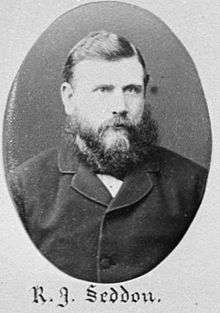
| Parliament of New Zealand | ||||
| Years | Term | Electorate | Party | |
| 1879–1881 | 7th | Hokitika | Independent | |
| 1881–1884 | 8th | Kumara | Independent | |
| 1884–1887 | 9th | Kumara | Independent | |
| 1887–1890 | 10th | Kumara | Independent | |
| 1890–1893 | 11th | Westland | Liberal | |
| 1893–1896 | 12th | Westland | Liberal | |
| 1896–1899 | 13th | Westland | Liberal | |
| 1899–1902 | 14th | Westland | Liberal | |
| 1902–1905 | 15th | Westland | Liberal | |
| 1905–1906 | 16th | Westland | Liberal | |
Seddon first sought election to the New Zealand House of Representatives in the 1876 election, standing for the Hokitika electorate. In the two-member electorate, he came fourth out of five candidates.[11] In the 1879 election, he tried again, and was elected. He represented Hokitika to 1881, then Kumara from 1881 to 1890, then Westland from 1890 to his death in 1906. His son Tom Seddon succeeded him as MP for Westland.
In Parliament, Seddon aligned himself with George Grey, a former Governor turned Premier. Seddon later claimed to be particularly close to Grey, although some historians believe that this was an invention for political purposes. Initially, Seddon was derided by many members of Parliament, who mocked his "provincial" accent (which tended to drop the letter "h") and his lack of formal education. He nevertheless proved quite effective in Parliament, being particularly good at "stonewalling" certain legislation. His political focus was on issues of concern to his West Coast constituents. He specialised on mining issues, became a recognised authority on the topic, and chaired the goldfields committee in 1887 and 1888.[12]
He aggressively proclaimed a populist anti-elitist philosophy in many speeches and toast. "It is the rich and the poor; it is the wealthy people and the landowners against the middle classes and the labouring classes," he explained.[13]
Liberal Party
Seddon joined the Liberal Party, led by John Ballance, following the December 1890 general election. Their platform was for reform in the areas of land and labour.[14] They were greatly helped by the abolition of plural voting, which allowed landowners in each district they owned land in to vote in them.[14]
Seddon was sworn in to his first ministerial positions when the Liberals came to power in January 1891.[2] He became minister of public works, mines, defence, and marine. He promoted co-operative contract system for road-making and other public works projects.
Unlike Ballance who believed in classical liberalism, Seddon did not have any great commitment to any ideology. Rather, he saw the Liberals as champions of "the common man" against large commercial interests and major landowners. His strong advocacy for what he saw as the interests of ordinary New Zealanders won him considerable popularity. Attacks by the opposition, which generally focused on his lack of education and sophistication (one opponent said that he was only "partially civilised") reinforced his growing reputation as an enemy of elitism.
Seddon quickly became popular across the country. Some of his colleagues, however, were not as happy, accusing him of putting populism ahead of principle, and of being an anti-intellectual. John Ballance, now Premier, had a deep commitment to liberal causes such as women's suffrage and Māori rights, which Seddon was not always as enthusiastic about. Nevertheless, many people in the Liberal Party believed that Seddon's popularity was a huge asset for the party, and Seddon developed a substantial following.
Premiership
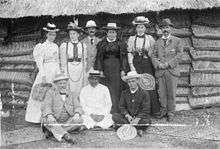
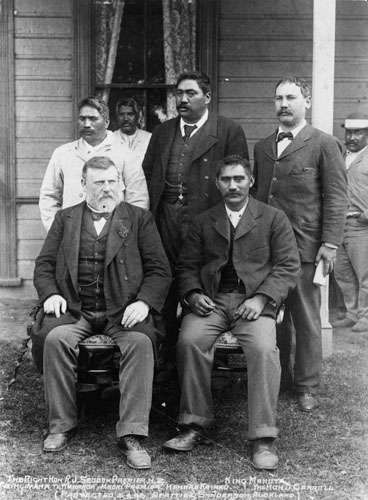
In 1892, Ballance fell seriously ill and made Seddon acting leader of the House. After Ballance's death in April 1893, the Governor David Boyle, 7th Earl of Glasgow asked Seddon, as the acting leader of the house, to form a new ministry. Despite the refusal of William Pember Reeves and Thomas Mackenzie to accept his leadership, Seddon managed to secure the backing of his Liberal Party colleagues as interim leader, with an understanding being reached that a full vote would occur when Parliament resumed sitting. Seddon's most prominent challenger was Robert Stout, a former Premier for two separate terms. Like Ballance, Stout had a strong belief in classical liberal principles. Ballance himself had preferred Stout as his successor, but had died before being able to secure this aim. Stout was not a member of the House of Representatives at the time of Ballance's death, and only re-entered following the by-election in Inangahua on 8 June 1893.
Despite Seddon's promise, however, there was no vote on the party leadership and therefore the premiership. By convincing his party colleagues that a leadership contest would split the party in two, or at least leave deep divisions, Seddon managed to secure a permanent hold on the leadership. Stout continued to be one of his strongest critics and led the campaign for women's suffrage despite Seddon's opposition. Eventually Stout left the Liberal Party in 1896 and remained in the house as an independent until 1898. In 1899 however, Seddon recommended Stout to the Governor as the next Chief Justice of New Zealand.
Women's suffrage
John Ballance, founder of the Liberal Party, had been a strong supporter of voting rights for women, declaring his belief in the "absolute equality of the sexes".[15] At the time women's suffrage was closely linked to the temperance movement, which sought prohibition of alcohol. As a former publican and self-styled champion of the "common man" Seddon initially opposed women's suffrage. In July 1893, two months after Seddon became Premier, the second of two major petitions for women's suffrage was presented to the House.[16]
This resulted in considerable debate within the Liberal Party. John Hall, a former conservative premier, moved a Bill to enact women's suffrage. Seddon's opponents within the party, led by Stout (also an advocate of temperance), managed to gather enough support for the Bill to be passed despite Seddon's opposition. When Seddon realised that the passage of the bill was inevitable, he changed his position, claiming to accept the people's will. In actuality, however, he took strong measures to ensure that the Legislative Council would vote down the Bill, as it had done previously. Seddon's tactics in lobbying the Council were seen by many as underhand, and two Councillors, despite opposing suffrage, voted in favour of the bill in protest. The Bill was granted Royal Assent in September.
Nonetheless, at the 1893 general election in November, Seddon's Liberal Party managed to increase its majority.
Alcohol licensing
The debate on women's suffrage exposed deep divisions within the Liberal Party between more doctrinaire liberals, broadly led by Stout, and "popular" liberals, led by Seddon. This division was again highlighted by the debate over alcohol licensing. Seddon moved the radical Alcoholic Liquors Sale Control Bill in 1893[17] to introduce licensing districts where a majority could vote for continuance (continued liquor licensing in that district) or reduction of licences or no liquor licences at all. Votes were to be taken every three years at general elections and licensing districts were matched to electoral districts.
Old-age pensions
One of the policies for which Seddon is most remembered is his Old-age Pensions Act of 1898, which established the basis of the welfare state later expanded by Michael Joseph Savage and the Labour Party. Seddon put considerable weight behind the scheme, despite considerable opposition from many quarters. Its successful passage is often seen as a testament to Seddon's political power and influence.
Foreign policy
In the sphere of foreign policy, Seddon was a notable supporter of the British Empire. After he attended the Colonial Conference in London in 1897, he became known "as one of the pillars of British imperialism", and he was a strong supporter of the Second Boer War and of preferential trade between British colonies. He is also noted for his support of New Zealand's own "imperial" designs – Seddon believed that New Zealand should play a major role in the Pacific Islands as a "Britain of the South". Seddon's plans focused mainly on establishing New Zealand dominion over Fiji and Samoa, but in the end, only the Cook Islands came under New Zealand's control during his term in office. (Samoa later came under New Zealand rule as well, but Fiji did not).
Style of government
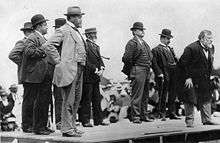
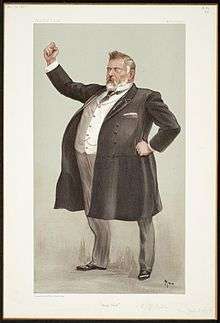
Seddon was a strong premier, and enforced his authority with great vigour. At one point, he even commented that "A president is all we require", and that Cabinet could be abolished. His opponents, both within the Liberal Party and in opposition, accused him of being an autocrat – the label "King Dick" was first applied to him at this point.
Seddon accumulated a large number of portfolios for himself, including that of Minister of Finance (from which he displaced Joseph Ward), Minister of Labour (from which he displaced William Pember Reeves), Minister of Education, Minister of Defence, Minister of Native Affairs, and Minister of Immigration.
Seddon was also accused of cronyism – his friends and allies, particularly those from the West Coast, were given various political positions, while his enemies within the Liberal Party were frequently denied important office. Many of Seddon's appointees were not qualified for the positions that they received – Seddon valued loyalty above ability. One account, possibly apocryphal, claims that he installed an ally as a senior civil servant despite the man being illiterate. He was also accused of nepotism – in 1905, it was claimed that one of his sons had received an unauthorised payment, but this claim was proved false.
Sir Carl Berendsen recalled seeing Seddon in 1906 as a Department of Education junior innocently bearing what was an unwelcome document. A replacement was needed for a small native school. The inspectors had picked out three outstanding candidates, but Seddon picked out the last on the lengthy list; he had no academic qualifications and had just been released from gaol for embezzlement. When the Premier appointed the gentlemen from gaol, Departmental officials returned the papers and called attention to his criminal record. Berendsen cowered in the corner while with a snarl Seddon grasped his pen and wrote once more in very large letters, "Appoint Mr X". Berendsen noted though that when an Editor was required for the new School Journal, Departmental officials had agreed on the best man, but the Massey Government (which had replaced the Liberal Government) was "quite shameless in devotion to the principle of the loaves and fishes ... and the Minister of the day appointed the third choice".[18]
As Minister of Native Affairs, Seddon took a generally "sympathetic" but "paternalistic" approach. As Minister of Immigration, he was well known for his hostility to Chinese immigration – the so-called "Yellow Peril" was an important part of his populist rhetoric, and he compared Chinese people to monkeys. In his first political speech in 1879 he had declared New Zealand did not wish her shores to be "deluged with Asiatic Tartars. I would sooner address white men than these Chinese. You can't talk to them, you can't reason with them. All you can get from them is 'No savvy'."
Successive governments had also shown a lack of firmness in dealing with Maori, he said: "The colony, instead of importing Gatling guns with which to fight Maori, should wage war with locomotives" ... pushing through roads and railways and compulsorily purchasing "the land on both sides".[19]
Freemasonry
In 1868, Seddon became a Freemason, being initiated into the Pacific Lodge in Hokitika.[20] In 1898, while premier, he was elected Grand Master of New Zealand,[21] and served in that role for two years.[20]
Honours
Seddon attended Queen Victoria's Diamond Jubilee and received her Jubilee Medal and an appointment in the Privy Council. In 1902 he attended the coronation of King Edward VII and Queen Alexandra and received his Coronation Medal.[22] During the same visit, he received the Freedom of the Borough of his home-town St Helens during a visit there in July 1902.[23]
He twice refused a knighthood, wanting to be seen as a man of the people.[24]
Death
Seddon remained Prime Minister for 13 years, but gradually, calls for him to retire became more frequent. Various attempts to replace him with Joseph Ward met with failure.
In June 1906, while returning from a trip to Australia on the ship Oswestry Grange, Seddon had a massive heart attack and died suddenly 12 days before his 61st birthday.[25] News of his death provoked numerous public gestures of grief, which including black bordered displays in shop windows and several public monuments, including a memorial Lamp Post outside the St Helens Hospital in Pitt Street Auckland. Seddon was buried in Wellington's Bolton Street Memorial Park, with his grave being marked by a large monument.
Legacy
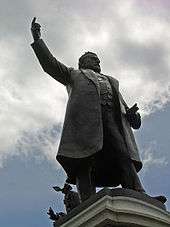
Seddon's son Thomas replaced him as MP for Westland in the by-election following his death. When Thomas met former US President Theodore Roosevelt in 1918, he expressed admiration for his late father, particularly the labour legislation his government passed.[26]
A statue of Seddon is located outside Parliament Buildings, and another has a prominent position in the West Coast town of Hokitika. A town in New Zealand and a suburb of Melbourne, Australia are named after him. Wellington Zoo was originally created when a young lion was presented to Prime Minister Richard Seddon by the Bostock and Wombwell Circus. Seddon created the Zoo from this single specimen and the lion was later named King Dick in the Prime Minister's honour. The stuffed body of King Dick (the lion) is displayed on the ground floor of the Museum of Wellington City & Sea. St Mary's Church in Addington, Christchurch also has a memorial bell tower to Richard Seddon.[27]
The Duke of Argyll unveiled a memorial to Seddon in St.Paul's Cathedral,London, probably in 1910. It shows a portrait of Seddon with the inscription "TO THE MEMORY OF RICHARD JOHN SEDDON PRIME MINISTER OF NEW ZEALAND 1893–1906 IMPERIALIST STATESMAN REFORMER BORN JUNE 22nd 1845 AT St HELENS LANCASHIRE BURIED AT OBSERVATORY HILL WELLINGTON NEW ZEALAND"
Notes and references
Notes
- ↑ "Prime Minister: The Title "Premier"". An Encyclopaedia of New Zealand. 1966. Retrieved 5 January 2015.
- 1 2 3 Hamer 2014, p. 1.
- ↑ Brooking 2014, p. 17.
- ↑ Brooking 2014, p. 51.
- ↑ Brooking 2014, p. 13.
- ↑ Brooking 2014, p. 54.
- ↑ Brooking 2014, p. 2.
- ↑ "Cunliffe's great-uncle Dick". Grey Star. Retrieved 14 January 2015.
- ↑ Wolfe 2005, p. 100.
- ↑ Burdon 1955, p. 40.
- ↑ "Declaration of the Poll". West Coast Times (3219). 19 January 1876. p. 2. Retrieved 20 February 2015.
- ↑ Hamer 2006.
- ↑ New Zealand House of Representatives (1884). Parliamentary Debates. p. 171.
- 1 2 Wolfe 2005, p. 89.
- ↑ "Story: Ballance, John". Te Ara: The Encyclopedia of New Zealand. 4 June 2013. Retrieved 7 January 2015.
- ↑ "Women and the vote Page 7 – About the suffrage petition". Retrieved 8 January 2015.
- ↑ "PROHIBITION - The Act of 1893". An Encyclopaedia of New Zealand. 1966. Retrieved 8 January 2015.
- ↑ Berendsen 2009, pp. 50, 56.
- ↑ Scott 1975, chpt. 10.
- 1 2 Burdon, Randal Mathews (1966). "Seddon, Richard John". In McLintock, A.H. An Encyclopaedia of New Zealand. Retrieved 21 February 2015.
- ↑ "Richard Seddon, Grand Master". Te Ara – the Encyclopedia of New Zealand. Ministry for Culture and Heritage. 16 November 2012. Retrieved 21 February 2015.
- ↑ "Object: Queen Victoria Diamond Jubilee Medal, 1897". Museum of New Zealand Te Papa Tongarewa.
- ↑ "Mr. Seddon at St Helens". The Times (36813). London. 7 July 1900. p. 4.
- ↑ Gavin McLean (21 August 2014). "Richard Seddon - Biography". nzhistory.net.nz. Retrieved 5 February 2015.
- ↑ Brooker 2014, p. 261.
- ↑ Seddon 1968, p. 299.
- ↑ "St Mary's Addington A heritage church in the heart of Addington". St Mary's Addington. Retrieved 28 January 2015.
References
- Berendsen, Carl (2009). Mr Ambassador: Memoirs of Sir Carl Berendsen. Wellington: Victoria University Press. ISBN 9780864735843.
- Brooking, Tom (2014). Richard Seddon: King of God's Own. Auckland: Penguin. ISBN 9780143569671.
- Burdon, Randal Mathews (1955). King Dick: A Biography of Richard John Seddon. Christchurch: Whitcombe and Tombs.
- Hamer, David A. (1988). The New Zealand Liberals: The Years of Power, 1891–1912. Christchurch.
- Hamer, David A. (2006). Seddon, Richard John (1845–1906). Christchurch: Oxford Dictionary of National Biography.
- Hamer, David A. (2014). Seddon, Richard John (1845–1906). Wellington: Te Ara: The Encyclopedia of New Zealand.
- Lipson, Leslie (2011) [1948]. The Politics of Equality: New Zealand’s Adventures in Democracy. Wellington: Victoria University Press. ISBN 978-0-86473-646-8.
- Nagel, Jack H. (1993). Populism, heresthetics and political stability: Richard Seddon and the art of majority rule. Christchurch: British Journal of Political Science. pp. 139–175. JSTOR 194246.
- Seddon, Thomas (1968). The Seddons, An Autobiography. Auckland, London: Collins.
- Scott, Dick (1975). Ask That Mountain: The Story of Parihaka. Heinemann.
- Wolfe, Richard (2005). Battlers Bluffers and Bully-boys: How New Zealand's Prime Ministers Have Shaped Our Nation. Random House, New Zealand. ISBN 1-86941-715-1.
Further reading
- The Life and Work of Richard John Seddon by James Drummond, Whitcombe and Tombs Limited, 1907. Book-length biography, digitised by the New Zealand Electronic Text Centre.
External links
| Wikimedia Commons has media related to Richard Seddon. |
- Sketch of Richard Seddon asleep in Parliament during an all-night sitting, 1898
- The Seddon-Stout struggle
| Government offices | ||
|---|---|---|
| Preceded by John Ballance |
Prime Minister of New Zealand 1893–1906 |
Succeeded by William Hall-Jones |
| Political offices | ||
| Preceded by William Campbell Walker |
Minister of Education 1903–1906 |
Succeeded by William Hall-Jones |
| Party political offices | ||
| Preceded by John Ballance |
Leader of the Liberal Party 1893–1906 |
Succeeded by William Hall-Jones |
| New Zealand Parliament | ||
| Preceded by Seymour Thorne George Edmund Barff |
Member of Parliament for Hokitika 1879–1881 Served alongside: Robert Reid |
Succeeded by Gerard George Fitzgerald |
| New constituency | Member of Parliament for Kumara 1881–1890 |
Constituency abolished |
| Vacant Constituency recreated after abolition in 1868 Title last held by William Sefton Moorhouse |
Member of Parliament for Westland 1890–1906 |
Succeeded by Tom Seddon |